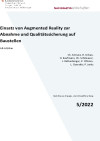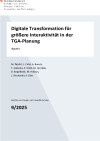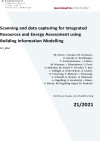Suchergebnisse für "Factsheet: Energietechnologien gestalten, die für alle sinnvoll und nutzbar sind"
Einsatz von Augmented Reality zur Abnahme und Qualitätssicherung auf Baustellen (AR-AQ-Bau)

Ziel dieses Forschungsprojektes ist die Entwicklung eines baustellentauglichen Augmented-Reality-(AR)-Systems inklusive eines Remote-Expert-System und eines BIM-Closed-Loop Datenübertragungssystem zur Verbesserung der Bauqualität, Gebäudesicherheit und Energieeffizienz sowie zur Effizienzsteigerung im Baucontrolling.
Schriftenreihe
5/2022
Ch. Schranz, H. Urban, H. Kaufmann, Ch. Schönauer, J. Rattenberger, P. O’Brien, L. Ozeraitis, P. Jaritz
Deutsch, 62 Seiten
Downloads zur Publikation
Digitale Transformation für größere Interaktivität in der TGA-Planung (digiaktiv)

Das Projekt digiaktiv verfolgte, eine Verbesserung der Interoperabilität zwischen den unterschiedlichen Baugewerbegewerken durch neutrale, offene semantische Datenmodelle zu ermöglichen. Dabei trägt digiaktiv mittels digitaler Transformationsprozesse zur Steigerung der Planungsqualität und dem Betrieb von Bauwerken, sowie zur Minimierung des Schnittstellenrisikos bei.
Schriftenreihe
9/2025
M. Šipetić, J. Catal, A. Buruzs, T. Natiesta, P. Hölzl, M. Herzlieb, B. Beigelböck, M. Hollaus, L. Bischanka, K. Eder
Herausgeber: BMK
Deutsch, 62 Seiten
Downloads zur Publikation
Digitaler Zwilling / Building Tracker - Kopplung der Gebäudesimulation mit physischen Gebäuden in Echtzeit
Ziel des Projektes ist die Kopplung eines Bürogebäudes in der Betriebsphase mit seinem virtuellen Zwilling, dem "Building-Tracker", der im Projekt entwickelt und erstmalig eingesetzt wird. Mit Hilfe der Kopplung von Monitoring und Simulation ist ein innovatives Gebäudeenergiemanagement zur Erreichung von nahe Nullenergiegebäuden möglich.
AFOM - Automatisierte Fehler- & Optimierungsanalyse durch Messdatenerfassung
Im Projekt sollen Methoden entwickelt werden, um aus den Messwertverläufen Informationen über den Betrieb sowie Betriebsveränderungen zu erkennen und einer Fehlerbehandlung zuführen zu können. Durch die Einbindung von BIM-Daten aus dem Gebäude sollen entsprechende Modelle zur Validierung der Heizung, Lüftung, Klima (HLK)-Netzwerke erzeugt werden, welche zur Analyse herangezogen werden.
openBAM - Open Building Automation Modelling - Offene Modellierung der Gebäudeautomation über den gesamten Gebäudelebenszyklus
Plattform-unabhängige Modellierung der Steuerungs- und Regelungslogik zur detaillierten Untersuchung von Gebäudeautomationssystemen mit Bautechnik und Gebäudetechnik. Das Ergebnis ermöglicht es, Energieeinsparungspotenziale durch Gebäudeautomation schon vor der Ausführung digital zu analysieren.
ReSpace – Reclaiming Spaces
ReSpace entwickelt ein KI-gestütztes Modell zur Identifikation, Kategorisierung und Aktivierung versiegelter Flächen. Dabei werden bestehende Datenquellen (Luft- und Satellitenbilder, Mobilfunkdaten, Grundbucheinträge) integriert und mit einer dynamischen Analyse angereichert, um evidenzbasierte Handlungsempfehlungen abzuleiten.
Build4Climate - Demonstrationsgebäude mit Klimaraum-Konzept am Campus der Lakeside Science & Technology Park GmbH in Kärnten
Nahe des Wörthersees in Kärnten entsteht ein modernes OpenSpace Forschungs- und Büroeinheitengebäude mit flexibler Nutzung innerhalb des Campus des Lakeside Science & Technology Park GmbH. Dieses innovative Gebäude wird als ‚Leuchtturm‘ mit einem „Klimaraum“-Konzept, das auf Bauteilaktivierung und umfassender Nutzung von erneuerbaren Energieträgern basiert, umgesetzt.
Scanning and data capturing for Integrated Resources and Energy Assessment using Building Information Modelling (SCI_BIM)

Ziel dieses Projekts ist, durch Kopplung unterschiedlicher digitaler Technologien und Methoden zur Datenerfassung- (Geometrie und materielle Zusammensetzung) und Modellierung (as-built BIM) die Steigerung der Ressourcen- und Energieeffizienz mittels Gamification Ansatz zu ermöglichen.
Schriftenreihe
21/2021
M. Honic, I. Kovacic, M. Sreckovic, G. Gourlis, H. Rechberger, P. Aschenbrenner, J. Fellner, M. Wimmer, I. Gilmutdinov, U. Pont, A. Mahdavi, M. Schuß, P. Ferschin, P. Kan, I. Schlögel, A. Hinterleitner, K. Löcker, R. Totschnig, P. Meixner, I. Greussnig, S. Schmidt, H. Steiner, G. Uhlariova, A. Ragoßnig, K. Kondracki, J. Maier, U. Moroz, M. Ragoßnig-Angst, M. Raskovic
Herausgeber: BMK
Deutsch, 62 Seiten
Downloads zur Publikation
BIM2BEM Flow - Kontinuierliche, BIM-basierte Energieeffizienzplanung
Durch eine automatisierte Integrierung und Zuweisung der Austauschanforderungen zwischen Entwurfs- und Simulationsprogramm anhand der ausgearbeiteten Austauschinformationsanforderungen, soll eine kontinuierliche Energieeffizienzplanung entlang der Entwurfsphase ermöglicht werden.
ReSpace – Reclaiming Spaces
ReSpace is developing an AI-based model for identifying, categorizing, and activating sealed areas. Existing data sources (aerial and satellite images, mobile network data, land registry entries) are integrated and enhanced with dynamic analysis to derive evidence-based recommendations for action.
Urban Sky - Satellite-based planning and analysis applications for climate-neutral and resilient cities
The project investigates how satellite data can support cities and municipalities (e.g. urban development, spatial energy planning, mobility transition). Based on demand and potential analyses, service concepts will be derived that integrate existing data and tools with satellite applications. The results will be presented in a study and a Space4Cities implementation roadmap.
BIMstocks - Digital Urban Mining Platform: Assessing the material composition of building stocks through coupling of BIM to GIS
The main goal of BIMstocks is the development of a method for the digital capturing of the material composition of the existing building stock for follow up modelling of an Urban Mining Platform as well as for the prediction of the recycling potentials.
3D*3B - 3D-Concret Printing, Reinforcement for low carbon and bending stressed structures.
The project is about 3D printed structural elements and their integration in building structures. The focus is predominantly set on bending stresses structural elements like panels and slabs. Results will point out technical, logistic and climate relevant aspects.
M-DAB - Digitise, analyse and sustainably manage the city's material resources
The research project investigates how digital technologies can support us in determining the existing and future material resources in construction qualitatively (building materials and their recycling) and quantitatively (quantities of building materials).
BIMpeco - Environmentally relevant product data in collaborative BIM environments
Construction products can pose a risk to the environment and health due to their pollutant content or releases. In the BIMpeco project, workflows and data structures for digital information management of this environmentally relevant product data are developed. For this purpose, the new ISO standards ISO 23387 and ISO 19650-1 are tested and synchronized with established process flows. The project results will be made available on an open-source basis and can be integrated into any Common Data Environment (CDE) that complies with the standards mentioned. The BIMpeco project is the first to lay the foundations for product information management of environmentally relevant properties in the CDE, covering the entire lifecycle and supply chain.
BIM2BEM Flow - Continuous BIM-based energy efficient planning
Automated integration and assignment of exchange requirements between the design and simulation programs, based on the elaborated exchange information requirements, should enable continuous energy efficiency planning along the design phase.
digiactiv - digital transformation for more interactivity in MEP-(mechanical, electrical and plumbing-)planning
The aim of the digiactiv project was to improve the interoperability between the different stakeholders in the building construction sector using open and neutral semantic data models. With digital transformation processes, digiactiv helps to increase the quality of planning and the operation of buildings, as well as to minimize the interface risk between various stakeholders.
KityVR - Artificial intelligence techniques to implement CityGML models and VR visualization
The goal of the project is to link 3D city models and virtual reality for energy-relevant applications as key-enabler for digital planning, construction and operational management. Missing data will be calculated using statistical enrichment methods.
AFOM - Automatic failure and optimisation analysis by data-acquisition
In the project, methods will be developed for analysing measured value curves to detect changes in operation or failures in the system. By integrating BIM data of buildings, corresponding models will be generated to validate the heating, ventilation, and air conditioning (HVAC)-networks, which will be used for analysis.
VR4UrbanDev - Virtual Reality as an innovative, digital tool for the integrative urban development of the future
Virtual reality (VR) has the potential to make complex issues more quickly comprehensible and directly tangible. In the VR4UrbanDev project, we are using this potential for energy planning processes for buildings and urban districts. On the basis of test areas, we develop methods for importing and visualising energy-related real-time data and simulation data in the VR environment.
